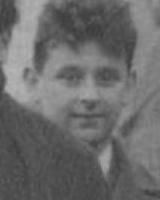Max Herzberger
Maximilian "Max" Jacob Herzberger (born March 7, 1899 in Berlin - Charlottenburg ; † April 9, 1982 in New Orleans ) was a German-American mathematician who dealt with geometric optics .
Life
Herzberger, the son of the businessman Leopold Herzberger, already stood out at high school with his mathematical talent and was therefore exempt from mathematics lessons. After graduating from high school at Schiller-Realgymnasium in Berlin and Jena in 1917, he studied mathematics and physics and received his doctorate in mathematics under Issai Schur in Berlin in 1923 (on systems of hypercomplex quantities). He then worked at Emil Busch AG in Rathenow, at Leitz in Wetzlar and, from 1927, at Carl Zeiss AG in Jena. Despite almost unanimous approval - with a dissenting vote - the mathematics and natural science faculty in Jena rejected a habilitation in 1930 by the Thuringian ministry and in 1934 he was dismissed from Carl Zeiss (disregarding the foundation regulations) because he was Jewish. He went to Holland, where he lectured at the TH Delft , worked in the Soviet Union in 1934/35 and then worked for Eastman Kodak in London. In 1935 he went to the USA and spent 30 years with Eastman Kodak in Rochester. From 1965 to 1969 he was a lecturer in geometric optics at the ETH Zurich (Photography Institute, at the invitation of WF Berg). He was then a consulting professor at Louisiana State University until 1980 .
He was active in the field of geometric ray optics, in particular he dealt with the full three-dimensional case and not just two-dimensional idealizations. He developed a dispersion formula for the visible range down to the near infrared and used it, for example, in the development of superachromats (with Nancy McClure 1963). In 1935, together with Hans Boegehold (his colleague at Zeiss), he proved that a rotationally symmetrical, non-telescopic optical system can represent at most two object surfaces sharply in geometric optics.
He published the optics work (Commentationes Optice, Part 4) in the Euler complete edition. He was a student and friend of Albert Einstein , who also wrote him a letter of recommendation for Eastman Kodak in the USA and with whom he corresponded.
In 1957 he became a corresponding member of the Bavarian Academy of Sciences. In 1962 he received the Frederic Ives Medal of the Optical Society of America (OSA) and was a lecturer for the OSA in 1962/63.
He was married to Edith Kaufmann and had three children. In 1940 he became a US citizen.
Fonts
- Radiation Optics, Basic Teachings of Mathematical Sciences , Springer 1931
- Modern geometrical optics, Pure and Applied Mathematics 8, Interscience 1958
Some essays:
- On the application of the basic laws of geometric optics to other physical systems, Physikalische Zeitschrift 32, 1931, 551–553
- About a principle of duality in optics, Zeitschrift für Physik, 91, 1934, 323–328
- with Boegehold: Spherical Symmetrical Systems, Journal for Applied Mathematics and Mechanics (ZAMM), 15, 1935, 157–178
- Attempt to rebuild Gaussian optics using the optical duality principle, Physica 2, 1935, 239-254
- First order laws in asymmetric optical systems, 1,2, J. Optical Society of America, 26, 1936, 354-359, 389-406
- Hamilton's characteristic function and Bruns Eikonal, J. Opt. Soc. Am., 27, 1937, 135-137
- Optics in the large, J. Opt. Soc. Am., 27, 1937, 202-206
- Gaussian optics and Gaussian brackets, J. Opt. Soc. Am., 33, 1943, 651-655
- Direct methods in geometrical optics, Transactions Am. Math. Soc., 53, 1943, 218-229
- Studies in Optics 1,2, Quarterly J. Appl. Math., 2, 1944, 196-204, 1945, 336-341
- Image error theory for finite aperture and fields, J. Opt. Soc. Am., Vol. 38, 1948, 736-738, Vol. 42, 1952, 306-321
- Color Correction in Optical Systems and a New Dispersion Formula. In: Journal of Modern Optics. 6, No. 3, 1959, pp. 197-215 (dispersion formula)
- An analysis of the Euler-Lagrange equations, Prakt. Akad. Athenon, 36, 1961, 369-378
- with N. McClure: The design of superachromatic lenses, Applied Optics 2, 1963, 553-560
- Some recent ideas in geometrical optics (Ives Medal Award Lecture), J. Opt. Soc. Am., 53, 1963, 661-671
- with Donald R. Wilder: Characteristic functions for special image formations and for a general thick lense, J. Opt. Soc. Am., 54, 1965, 773-790
literature
- Maximilian Pinl Colleagues in a Dark Time , Annual Report DMV, Volume 73, 1971, pp. 168–169
- Maximilian J. Herzberger: Ives Medalist for 1962, J. Opt. Soc. Am., 53, 1963, 657-660
Web links
- Jakob Jütz: Dr. Max Herzberger (1899–1982), a pioneer of mathematical ray optics, Mitt. Swiss Society for Optics and Microscopy, 2010, pdf
References and comments
| personal data | |
|---|---|
| SURNAME | Herzberger, Max |
| ALTERNATIVE NAMES | Herzberger, Maximilian Jacob (full name); Herzberger, Max Jacob (nickname) |
| BRIEF DESCRIPTION | German-American mathematician |
| DATE OF BIRTH | March 7, 1899 |
| PLACE OF BIRTH | Berlin -Charlottenburg |
| DATE OF DEATH | April 9, 1982 |
| Place of death | New Orleans |
